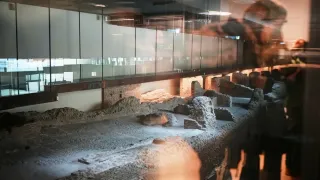June 5, 2016
Mummy Dearest
Sura Wood READ TIME: 4 MIN.
The unfurling of Egyptian mummies, a spectacle once performed in front of rapt Victorian audiences, was an evening's entertainment for segments of 19th-century English society in the throes of "Egyptomania." Legend has it that the bodies were so well-preserved one could see what the deceased looked like in life for a split-second before they disintegrated, vanishing into dust.
It would seem that the Egyptians, who made elaborate preparations for eternal life, equipping their tombs with provisions and servants to accompany them on the passage to the netherworld, have succeeded in their quest for immortality, if only because centuries after the demise of their civilization, we're still compelled to unlock their secrets.
It has been 200 years since those mummy parties in England, and new advances in 3-D imaging technology have now made it possible to penetrate some of the mysteries - and actually see inside mummies - without destroying them. A pair of these emissaries from the distant past, which belong to the Fine Arts Museums, underwent CT scans at Stanford University School of Medicine's radiology department. The results, on view in "The Future of the Past: Mummies and Medicine," a jewel-box exhibition at the Legion of Honor curated by Renee Dreyfus, are both ghoulish and awe-inspiring.
At the nexus of science, archaeology, religion and ancient history, the show, displayed in a single gallery whose dim, spooky lighting suggests the interior of a tomb, includes ritual objects associated with death and burial, such as a gilded mummy mask, canopic jars that once stored internal organs like one here with the carved head of a jackal, and azure blue faience shabtis, invisibly suspended in a glass case - the tiny, sculpted figures were believed to possess magical powers that guarded against performing distasteful tasks in the afterlife. A virtual interactive dissection table allows visitors to rotate and slice animations of simulated mummies, while forensic facial reconstructions fill out a picture of how these very real individuals may have looked when they were alive; a text panel nearby offers a detailed description of the complex, arcane process of mummification.
Egypt's hot, dry climate was advantageous for preservation, but ritual practices varied on the period, wealth and status of the deceased. In earlier dynasties, the bodies were swathed in cloth or skins and buried in graves on the fringes of the desert. It may seem counterintuitive, but this relatively unsophisticated approach was more effective at preventing decomposition than the intricate procedures undertaken later, towards the end of the New Kingdom, when bodies were emptied of parts, the viscera removed and stored elsewhere and the brain discarded; the heart, considered the seat of emotion and thought, stayed where it was. The body would be soaked in a dehydrating agent for over 40 days before its cavity was repacked with yards of resin-coated linen, and the entire package was anointed with oils, amulets and jewels, and sealed in a coffin.
Of course, the mummies - Irethorrou, a male of high status, and Hatason, 500 years older and presumed to be a middle-class female - are the stars of show. A member of a prominent family of the Saite period (664-525 BC), Irethorrou, thought to be 45 years old at his death, was a wardrobe priest serving the fertility god Min, among other important ceremonial duties, in middle Egypt 2,600 years ago. His coffin (ca. 500 BC), which has a carved, beautifully painted face and is made from cedar, a valuable commodity at the time, is in remarkable condition, as is the well-preserved mummy that resides within. The box is propped upon to enable the viewing of the body; one can detect the contours of the skull underneath bandages that somehow have survived intact. The rotating scan reveals his pelvis was filled with several bags containing unknown substances, and that portions of his internal organs were wrapped after being mummified and placed back inside the body. Embalmers removed his brain through a nasal passage, and amulets and scarabs, instilling magic related to resurrection, were placed at strategic points.
The mummy known as Hatason (not her real name) came from the West Bank of the Nile and was a petite woman of about 50 or 60 when she died sometime during early Dynasty 22 (ca. 960-880 BC). Her damaged mummy and her simple wood coffin, not as ornate as Irethorrou's, betray the ravages of their journey through time. Though her skeleton is broken, her brain is still in place, as was the practice of her era, and she evidently suffered severe gum disease, a malady we share with the Egyptians.
Also noteworthy is a towering, anthropoid or human-shaped inner coffin (380-340 BC) inscribed with a spell from the Book of the Dead to ensure safe passage to the other side. But the most spectacular object is quite small, an exquisite carving of Seneb, the royal scribe (1938-1850 BC), who seems to have stepped out of the pages of history. Sculpted so that the wood grain heightened the vertical lines of the body and painted a dark earthy brown, it's a portrait of a reed-slim, acetic man with a shaved head, fine facial features and long slender arms, a narrow white kilt tucked at his waist.
Here's hoping we can look forward to larger-scale antiquities exhibitions from Dreyfus, an inspiring scholar and invaluable resource in this or any community. (Through Aug. 26.)






